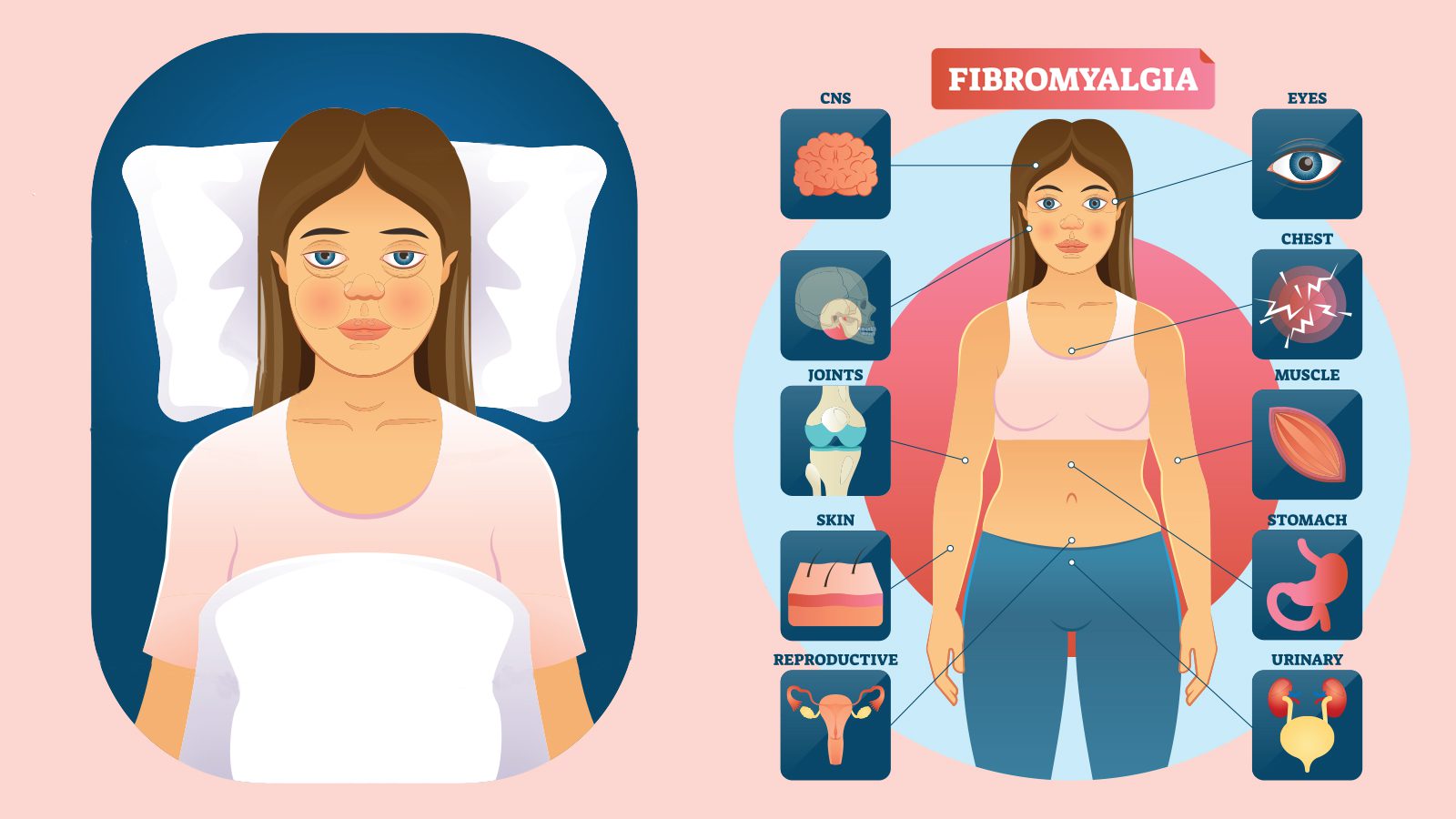Fibromyalgia is a long-lasting condition best known for causing widespread muscle pain or weakness throughout the body. It also causes other issues, including fatigue and cognitive problems, amongst many other symptoms. The signs of fibromyalgia interfere with your ability to function at work or home, and it’s often a misunderstood issue.
Research shows that women are more likely to suffer from this condition than men, but it can happen to men. Most patients become diagnosed between 35 and 45, although signs of fibromyalgia start much sooner.
The signs of fibromyalgia often begin after physical trauma, infection, surgery, psychological stress, or another significant event. There isn’t a cure for the condition, but you can work with a professional to control your symptoms. Stress management, relaxation, and exercise are all helpful ways to lessen the pain.
Ten Signs of Fibromyalgia
If you experience any of these signs of fibromyalgia, consider reaching out to a medical professional for an official diagnosis. You don’t have to let the symptoms control your life, as there are ways to manage them.
1. Pain
This condition causes constant dull pain that feels like it’s starting in your muscles. Professional testing will show no damage to the tissues despite the never-ending pain. People with this condition are often more sensitive to pain, experiencing a painful sensation when most people would feel mild discomfort.
The pain acts as an aching, burning, or throbbing feeling. It is commonly felt in the following body parts:
- Legs
- Chest
- Arms
- Head
- Buttocks
- Back
- Abdomen
The pain from this condition will be intense and constant. Sometimes it’ll be severe enough to stop you from going to work or living a social life. Many people diagnosed report experiencing pain most or all days of their lives.
2. Migraine Attacks or Tension Headaches
Research shows that more than half of the people with fibromyalgia experience migraine attacks or tension headaches. When you have a migraine, your head will throb, and you might experience nausea and vomiting.
Migraines might also cause light and sound sensitivity, making you want to lie in a dark room. These headaches can occur from painful muscles in your head, neck, or shoulders.
3. Unexplainable Tiredness and Fatigue
Being extremely tired even after you get rest is one of the signs of fibromyalgia that you should never ignore. You might wake up tired, even if you went to sleep at a decent time the night before. Additionally, you might have trouble falling or staying asleep because the pain disrupts your sleep cycle.
When you fall asleep, you will experience less REM sleep, which is the stage of body restoration. Sometimes you’ll also develop sleep disorders such as sleep apnea.
Fatigue is one of the most difficult symptoms to deal with because it significantly impacts your life. Experts explain that it affects more than 90% of people diagnosed with fibromyalgia. You’ll lack energy, have decreased endurance, and your exhaustion will be draining and debilitating.
4. Brain Fog aka Fibro Fog
Sometimes referred to as fibro fog, this symptom describes cognitive issues that can occur with the condition. Not everyone develops brain fog, but many report the struggle.
If you have fibro fog, you might struggle with focusing your attention. It leads to distraction, forgetting or losing things, and not keeping up with conversations. You might feel like you can’t clear your head, leading to confusion and concentration issues.
5. Mental Health Issues
This condition leads to mental health issues, including anxiety, depression, and mood problems. Because it causes constant pain, it affects the central nervous system. With that area being affected, depression and intense emotional symptoms are common.
If you aren’t getting enough sleep or feel tired even after resting, it’ll only contribute to mental health issues. It can make you irritable, quickly leading to unpredictable moods.
6. Restless Leg Syndrome
Many of those diagnosed with this condition experience restless leg syndrome. It is an uncomfortable feeling that feels like a crawling feeling in your legs at night.
When you feel the sensation, you’ll want to keep moving your legs, preventing yourself from getting good sleep. It can sometimes wake you up, further hindering your sleep cycle.
7. Sensory Sensitivity
If you often experience sensory overload, it could be one of the signs of fibromyalgia. Research shows that it causes uncomfortable or painful feelings that other people don’t feel. This situation occurs because your brain processes the sensations differently.
The sensitivity might occur from touch or pressure, loud sounds, temperature changes, flavors, or unpleasant smells. It makes your environment seem noisy, bright, and painful. If you experience touch sensitivity, even slight pressure can cause pain.
8. Irritable Bowel Syndrome
Irritable Bowel Syndrome, or IBS, is a gastrointestinal disorder that causes digestive discomfort. Research shows that between 40 and 70% of people with fibromyalgia have also been diagnosed with IBS.
These conditions are similar because they cause your brain to be hypersensitive to stimuli. IBS affects your large intestine and can cause abdominal pain, nausea, bloating, gas, diarrhea, or constipation.
9. Rash or Itchy Skin
This condition sometimes causes a rash or itching. There aren’t many outward signs, so this is one of the visual ways you will know. It can cause dry skin and excess sweating, too.
10. Temporomandibular Joint Syndrome
Temporomandibular Joint Syndrome, or TMJ, causes pain near your jaw. As one of the signs of fibromyalgia, you don’t want to ignore it. You might notice that your jaw makes a popping or snapping noise when you open or close it.
If it gets bad enough, it could become hard to open your mouth fully to speak or chew. Additionally, TMJ can cause headaches and pain near your ears.
Causes of Fibromyalgia
Experts aren’t entirely certain of what causes the condition, but they are working on learning more. So far, they believe that this condition affects how your brain and spinal cord process pain, causing an increase in chemicals that signal pain. After a while of this increase, it causes your brain to remember the pain and experience pain from nonpainful signals.
This condition can also be genetic as it tends to run in families. Researchers believe that environmental factors also contribute, including too much stress and poor eating habits.
Some diseases increase your risk of developing this condition, too. These diseases include:
- Rheumatoid Arthritis
- Lupus
- Ankylosing Spondylitis
- Osteoarthritis
- Chronic Back Pain
You’ll likely have some periods where you feel better, but there will always be triggers. These triggers can begin your journey or cause a flare-up, and they include:
- Traumatic life events
- Abuse
- Accidents
- Viral infections or other illnesses
- Anxiety or depression
- PTSD
- Lack of exercise
- Poor sleep
Diagnosis of Fibromyalgia
For a diagnosis, you must experience widespread pain for at least three months. The pain must occur in at least four of five areas. These areas include the left or right upper region, left or right lower region, or the axial region.
The left and right upper regions include the shoulder, arm, or jaw, while the lower include the hip, buttock, or leg. Axial region pain occurs in the neck, back, chest, or abdomen for the axial region.
Your doctor might want blood tests to rule out other conditions with similar symptoms. They might also recommend a sleep study to check for sleep apnea.
Fibromyalgia Treatment
While there is no cure for fibromyalgia, you can treat it to improve the symptoms. Many self-care strategies and lifestyle changes can minimize symptoms and improve your well-being. One treatment won’t ease all complications, so it’s best to try a few and see what helps.
Therapy for Fibromyalgia
Those who suffer from signs of fibromyalgia can benefit from a few kinds of therapy. Physical therapy will help improve strength, flexibility, and stamina, with water exercises being most helpful.
Occupational therapy helps you adjust the way you perform tasks so that it causes less bodily stress. You’ll also learn how to change your work area to ease symptoms.
Counseling can help build self-esteem, resiliency, and strength. You’ll believe in yourself and your abilities to deal with stress.
Develop Stress Management Techniques
Give yourself time to relax each day, and plan to avoid overexertion of emotional stress. One effective way to do this is learning to say no without feeling guilty. Don’t drop all activities, but do give up things that no longer serve you.
Other stress management techniques are also beneficial, such as deep-breathing exercises. You can also try meditation to clear your mind and bring yourself to the present.
Set a Sleep Schedule and Stick to It
Practicing sleep hygiene is essential to getting good quality sleep. Set a sleep schedule, going to bed at the same time each night and waking up at the same time in the morning. Additionally, limit daytime napping to protect your nighttime schedule.
Exercise Regularly if You Have Fibromyalgia
You might think that exercise will increase your pain, but it decreases your symptoms. Try walking, swimming, biking, or aerobics. You can do these exercises comfortably, easing into more intense movement.
Yoga and Tai Chi
Yoga and tai chi involve slow movements, meditation, relaxation, and deep breathing. Both can help control your symptoms, allowing you to feel better each day.
Final Thoughts on Signs of Fibromyalgia Never to Ignore
The signs of fibromyalgia can be debilitating, so don’t ignore them. The sooner you receive a diagnosis, the sooner you can seek treatments to minimize your symptoms. Once you get control of your symptoms, you can live a better life. You’ll experience fulfillment and meaning as pain and discomfort will no longer consume your thoughts.



















